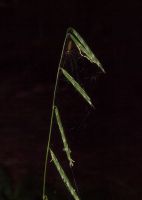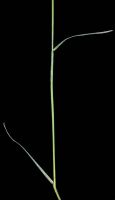Distribution: Occurring chiefly west of the Cascades crest in Washington; British Columbia to California.
Habitat: Bogs, stream banks, swampy meadows,and moist, shaded woods, from near sea level toabout 5000 feet elevation in the mountains.
Flowers: May-August
Origin: Native
Growth Duration: Perennial
Conservation Status: Not of concern
Pollination: Wind
Rhizomatous perennial, the culms 10-15 dm. tall, hollow, usually glabrous.
Sheathes closed at the base, but open for the upper 2-7 cm.; ligules 1.5-3.5 mm. long; blades 3-7 mm. broad, sometimes the uppermost reduced to 1 cm. in length.
Inflorescence a loose raceme 10-25 cm. long; spikelets 5-12, widely spaced, becoming reflexed, 7- to 11-flowered, up to 3 cm. long; glumes scarious, translucent, the first 4-5 mm. long, the second 6-7 mm. long, somewhat lobed; lemmas rounded on the back, with 7 prominent, non-converging nerves, 7-8 mm. long, often tri-lobed at the tip, with a terminal awn 3-10 mm. long; palea shorter than the lemma, with 2 winged keels .
Publication: Grass. U.S. 40. 1883.
PNW Herbaria: Specimen records of Pleuropogon refractus in the Consortium of Pacific Northwest Herbaria database
WA Flora Checklist: Pleuropogon refractus checklist entry
OregonFlora: Pleuropogon refractus information
E-Flora BC: Pleuropogon refractus atlas page
CalPhotos: Pleuropogon refractus photos




















